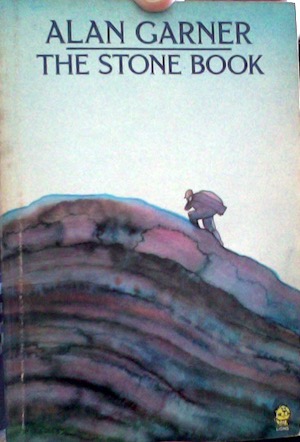Inspiring Young Readers
 posted on 15 Aug 2022
posted on 15 Aug 2022
The Stone Book Quartet by Alan Garner
Since rereading The Owl Service a few years ago (Letterpress review), and further prompted by coverage of The Weirdstone of Brisingamen (here) and Red Shift (here), I finally set about rereading some more Garner – hoping to rediscover the thrill and enchantment I felt when first reading him in the early-70s.
I was saddened but not surprised to find that The Weirdstone of Brisingamen and its follow-up, The Moon of Gomrath, no longer worked their intense spell on me. Most readers coming to them for the first time, however, will be swept along by the pace and adventure of the books and the way Garner mixes magic and elemental forces with the physical reality of specific places in the Cheshire landscape, most famously Alderley Edge.
I decided to try something else of Garner’s that might have retained its power and chose the four short, interconnected novels he published during the 1970s – The Stone Book (1976); Granny Reardun (1977); The Aimer Gate (1978); and Tom Fobble’s Day (1977) – now known as The Stone Book Quartet. Garner himself said at the time that his aim was to write again about Alderley Edge but this time ‘luminously’ rather than ‘magically’. There couldn’t be a better description.
These enigmatic and simply written little books, each one only fifty or sixty pages long, began to appear just three years after Garner’s challenging novel, Red Shift. Their apparent simplicity and fable-like nature left some feeling that they had mistakenly bought books intended for ‘younger readers’. But as the sequence progresses it is very clear that whatever age you might think these books are pitched at, they are written with the utmost gravity and seriousness of purpose. The rural landscape and community life are, as you might expect, luminously present, but more fundamentally the books are concerned with social change and the passage of time – the disappearance of an old agrarian life, the emergence of a craft-based industrial age, and the gradual displacement of the individual craftsman in favour of mechanised production. Garner is memorialising not just four generations of his family, he is also writing an elegy for a particular kind of rural working class life long since disappeared.
In the first, a little girl climbs the highest structure in her village – the church steeple – that her stonemason father is finally topping-off. She carries with her his ‘baggin’ of bread, onion and cold tea. Later he will introduce her to the mysteries of ‘deep’ geological time, taking her to an almost inaccessible inner chamber of a local mine where by the light of a guttering candle stub she sees prehistoric cave art. Her father’s father had similarly taken him when he was a child and it is of course significant that the passage to the inner chamber has over the years subsided and slipped so that it is now only accessible to a child willing to make the frightening final stages of the journey alone.
In the second novel, a young boy Joseph, who is about to finish school, decides that he will not follow his grandfather’s trade of stonemason: he wants his own trade, his own prospects, his own more secure future. He realises in a moment of epiphany that everything the mason builds – walls, churches, the local school – requires him to use tools that can only be made by a blacksmith. And that is what he will become.
In the third, a young boy Robert discovers a secret place too – but this isn’t deep below the ground but high above it: a mason’s mark at the highest point of the steeple, up ladders so thickly populated by roosting pigeons that he has to move them carefully aside with his feet as he climbs.
In the fourth, a young boy has his precious homemade sledge ‘Fobbled’ – won: in reality stolen – by an older, tougher lad. His grandfather, once the village smith, makes him a new one, its fine ash frame in part made from the long, graceful handle that had worked his furnace bellows. ‘Through hand and eye, block, forge and loom to the hill and all that he owned, he sledged sledged sledged for the black and glittering night and the sky flying on fire and the expectation of snow,’ this novel concludes. We are being reminded of the ties of family, certainly, but also of the unbroken chain of labour and skills and crafts that were the bedrock of these and similar communities.
I had forgotten how moving these novels are and reading them all together, one after the other, came as a revelation. Taken together they have a power that I don’t think was entirely evident when I first read each title as it was published. I haven’t seen the latest editions but I hope they have retained the beautifully sympathetic illustrations by Michael Foreman.
I will always return to those novels of Alan Garner’s that are closest to my heart – Elidor, The Owl Service, Red Shift – but I now realise that to this list must also be added The Stone Book Quartet for it may well be amongst his greatest achievements.
Alun Severn
August 2022



